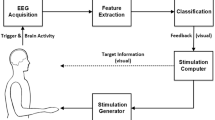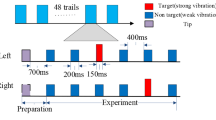Abstract
Purpose
Visual based brain-computer interface (BCI) has been widely investigated for the severely disabled patients. However, this modality is not applicable to the persons who have lost their visual function. This study aims to develop an alternative BCI using tactile stimuli only.
Methods
An event-related potential (ERP) based BCI applying vibrotactile stimuli was proposed. It featured a combination of frequency and spatial information as a cue for binary choices. Two identical mechanical vibrotactile tactors were tied to each index finger of the two hands of a subject, to provide vibrotactile stimuli at various frequencies and constitute a three-stimulus oddball paradigm with one attended stimulus, one ignored stimulus and one disturbance stimulus. Ten healthy subjects participated in the experiments, and the classification of P300 signals was conducted by a stepwise linear discriminate analysis algorithm.
Results
Significant P300 components were evoked at approximately 360 ms after the onset of the target stimuli for each subject, and an average classification accuracy of 79% was achieved.
Conclusions
This work demonstrates the feasibility of employing vibrotactile stimuli to build an ERP based BCI. The patients without a functional visual system could benefit from the presented paradigm.





Similar content being viewed by others
References
Wolpaw, J. R., Birbaumer, N., McFarland, D. J., Pfurtscheller, G., & Vaughan, T. M. (2002). Brain–computer interfaces for communication and control. Clinical Neurophysiology, 113(6), 767–791. https://doi.org/10.1016/S1388-2457(02)00057-3.
Farwell, L. A., & Donchin, E. (1988). Talking off the top of your head: Toward a mental prosthesis utilizing event-related brain potentials. Electroencephalography & Clinical Neurophysiology, 70(6), 510–523. https://doi.org/10.1016/0013-4694(88)90149-6.
Schreuder, M., Blankertz, B., & Tangermann, M. (2010). A new auditory multi-class brain-computer interface paradigm: spatial hearing as an informative cue. PLoS ONE, 5(4), e9813. https://doi.org/10.1371/journal.pone.0009813.
Brunner, P., Joshi, S., Briskin, S., Wolpaw, J. R., Bischof, H., & Schalk, G. (2010). Does the 'P300' speller depend on eye gaze? Journal of Neural Engineering, 7(5), 056013. https://doi.org/10.1088/1741-2560/7/5/056013.
Lewis, M., & Rushanan, S. (2007). The role of physical therapy and occupational therapy in the treatment of amyotrophic lateral sclerosis. NeuroRehabilitation, 22(6), 451–461.
Murguialday, A. R., Hill, J., Bensch, M., Martens, S., Halder, S., Nijboer, F., et al. (2011). Transition from the locked in to the completely locked-in state: a physiological analysis. Clinical Neurophysiology, 122(5), 925–933. https://doi.org/10.1016/j.clinph.2010.08.019.
Müller-Putz, G. R., Scherer, R., Neuper, C., & Pfurtscheller, G. (2006). Steady-state somatosensory evoked potentials: suitable brain signals for brain-computer interfaces? IEEE Transactions on Neural Systems and Rehabilitation Engineering, 14(1), 30–37. https://doi.org/10.1109/tnsre.2005.863842.
Brouwer, A.-M., & van Erp, J. B. F. (2010). A tactile P300 brain-computer interface. Frontiers in Neuroscience, 4, 19. https://doi.org/10.3389/fnins.2010.00019.
Severens, M., Van der Waal, M., Farquhar, J., & Desain, P. (2014). Comparing tactile and visual gaze-independent brain-computer interfaces in patients with amyotrophic lateral sclerosis and healthy users. Clinical Neurophysiology, 125(11), 2297–2304. https://doi.org/10.1016/j.clinph.2014.03.005.
van der Waal, M., Severens, M., Geuze, J., & Desain, P. (2012). Introducing the tactile speller: an ERP-based brain-computer interface for communication. Journal of Neural Engineering, 9(4), 045002. https://doi.org/10.1088/1741-2560/9/4/045002.
Guger, C., Spataro, R., Allison, B. Z., Heilinger, A., Ortner, R., Cho, W., et al. (2017). Complete Locked-in and Locked-in Patients: Command Following Assessment and Communication with Vibro-Tactile P300 and Motor Imagery Brain-Computer Interface Tools. Frontiers in neuroscience, 11, 251. https://doi.org/10.3389/fnins.2017.00251.
Herweg, A., Gutzeit, J., Kleih, S., & Kübler, A. (2016). Wheelchair control by elderly participants in a virtual environment with a brain-computer interface (BCI) and tactile stimulation. Biological psychology, 121(Pt A), 117–124. https://doi.org/10.1016/j.biopsycho.2016.10.006.
Kaufmann, T., Herweg, A., & Kübler, A. (2014). Toward brain-computer interface based wheelchair control utilizing tactually-evoked event-related potentials. Journal of neuroengineering and rehabilitation, 11, 7. https://doi.org/10.1186/1743-0003-11-7.
Kaufmann, T., Holz, E. M., & Kübler, A. (2013). Comparison of tactile, auditory, and visual modality for brain-computer interface use: a case study with a patient in the locked-in state. Frontiers in neuroscience, 7, 129. https://doi.org/10.3389/fnins.2013.00129.
Lugo, Z. R., Rodriguez, J., Lechner, A., Ortner, R., Gantner, I. S., Laureys, S., et al. (2014). A vibrotactile p300-based brain-computer interface for consciousness detection and communication. Clinical EEG and neuroscience, 45(1), 14–21. https://doi.org/10.1177/1550059413505533.
Hohne, J., Schreuder, M., Blankertz, B., & Tangermann, M. (2011). A Novel 9-Class Auditory ERP Paradigm Driving a Predictive Text Entry System. Frontiers in neuroscience, 5, 99. https://doi.org/10.3389/fnins.2011.00099.
Halder, S., Takano, K., Ora, H., Onishi, A., Utsumi, K., & Kansaku, K. (2016). An Evaluation of Training with an Auditory P300 Brain-Computer Interface for the Japanese Hiragana Syllabary. Frontiers in neuroscience, 10, 446. https://doi.org/10.3389/fnins.2016.00446.
Silvoni, S., Konicar, L., Prats-Sedano, M. A., Garcia-Cossio, E., Genna, C., Volpato, C., et al. (2016). Tactile event-related potentials in amyotrophic lateral sclerosis (ALS): Implications for brain-computer interface. Clinical Neurophysiology, 127(1), 936–945. https://doi.org/10.1016/j.clinph.2015.06.029.
Choi, I., Bond, K., Krusiensk, D., & Nam, C. S. (2015). Comparison of Stimulation Patterns to Elicit Steady-State Somatosensory Evoked Potentials (SSSEPs): Implications for Hybrid and SSSEP-Based BCIs. In 2015 EEE International Conference on Systems, Man, and Cybernetics, 9–12, 3122–3127. https://doi.org/10.1109/SMC.2015.542.
Halder, S., Rea, M., Andreoni, R., Nijboer, F., Hammer, E. M., Kleih, S. C., et al. (2010). An auditory oddball brain-computer interface for binary choices. Clinical Neurophysiology, 121(4), 516–523. https://doi.org/10.1016/j.clinph.2009.11.087.
Committee, E. P. N. (1991). American Electroencephalographic Society guidelines for standard electrode position nomenclature. Journal of clinical neurophysiology : official publication of the American Electroencephalographic Society, 8(2), 200–202.
Delorme, A., & Makeig, S. (2004). EEGLAB: an open source toolbox for analysis of single-trial EEG dynamics including independent component analysis. Journal of neuroscience methods, 134(1), 9–21. https://doi.org/10.1016/j.jneumeth.2003.10.009.
Krusienski, D. J., Sellers, E. W., Cabestaing, F., Bayoudh, S., McFarland, D. J., Vaughan, T. M., et al. (2006). A comparison of classification techniques for the P300 Speller. Journal of Neural Engineering, 3(4), 299–305. https://doi.org/10.1088/1741-2560/3/4/007.
Krusienski, D. J., Sellers, E. W., McFarland, D. J., Vaughan, T. M., & Wolpaw, J. R. (2008). Toward enhanced P300 speller performance. Journal of neuroscience methods, 167(1), 15–21. https://doi.org/10.1016/j.jneumeth.2007.07.017.
Serby, H., Yom-Tov, E., & Inbar, G. F. (2005). An improved P300-based brain-computer interface. IEEE Transactions on Neural Systems and Rehabilitation Engineering, 13(1), 89–98. https://doi.org/10.1109/TNSRE.2004.841878.
Cavrini, F., Bianchi, L., Quitadamo, L. R., & Saggio, G. (2016). A Fuzzy Integral Ensemble Method in Visual P300 Brain-Computer Interface. Comput Intell Neurosci, 2016, 1–9. https://doi.org/10.1155/2016/9845980.
Pires, G., & Nunes, U. (2009). A Brain Computer Interface methodology based on a visual P300 paradigm. In 2009 IEEE/RSJ International Conference on Intelligent Robots and Systems, 10–15, 4193–4198. https://doi.org/10.1109/IROS.2009.5354384.
Nakajima, Y., & Imamura, N. (2000). Relationships between attention effects and intensity effects on the cognitive N140 and P300 components of somatosensory ERPs. Clinical Neurophysiology, 111(10), 1711–1718. https://doi.org/10.1016/s1388-2457(00)00383-7.
Pang, C. Y., & Mueller, M. M. (2014). Test–retest reliability of concurrently recorded steady-state and somatosensory evoked potentials in somatosensory sustained spatial attention. Biological psychology, 100, 86–96. https://doi.org/10.1016/j.biopsycho.2014.05.009.
Reuter, E.-M., Voelcker-Rehage, C., Vieluf, S., Winneke, A. H., & Godde, B. (2014). Extensive occupational finger use delays age effects in tactile perception-an ERP study. Attention, perception & psychophysics, 76(4), 1160–1175. https://doi.org/10.3758/s13414-014-0634-2.
Hori, J., & Okada, N. (2017). Classification of tactile event-related potential elicited by Braille display for brain–computer interface. Biocybernetics and Biomedical Engineering, 37(1), 135–142. https://doi.org/10.1016/j.bbe.2016.10.007.
Breitwieser, C., Pokorny, C., & Muller-Putz, G. R. (2016). A hybrid three-class brain-computer interface system utilizing SSSEPs and transient ERPs. Journal of Neural Engineering, 13(6), 066015. https://doi.org/10.1088/1741-2560/13/6/066015.
Kübler, A., & Birbaumer, N. (2008). Brain–computer interfaces and communication in paralysis: Extinction of goal directed thinking in completely paralysed patients? Clinical Neurophysiology, 119(11), 2658–2666. https://doi.org/10.1016/j.clinph.2008.06.019.
Kaufmann, T., & Kübler, A. (2014). Beyond maximum speed–a novel two-stimulus paradigm for brain-computer interfaces based on event-related potentials (P300-BCI). Journal of Neural Engineering, 11(5), 056004. https://doi.org/10.1088/1741-2560/11/5/056004.
Gonsalvez, C. J., Barry, R. J., Rushby, J. A., & Polich, J. (2007). Target-to-target interval, intensity, and P300 from an auditory single-stimulus task. Psychophysiology, 44(2), 245–250. https://doi.org/10.1111/j.1469-8986.2007.00495.x.
Polich, J. (2007). Updating P300: an integrative theory of P3a and P3b. Clinical Neurophysiology, 118(10), 2128–2148. https://doi.org/10.1016/j.clinph.2007.04.019.
Brouwer, A.-M., van Erp, J. B. F., Aloise, F., & Cincotti, F. (2010). Tactile, Visual, and Bimodal P300s: Could Bimodal P300s Boost BCI Performance? SRX Neuroscience, 2010, 1–9. https://doi.org/10.3814/2010/967027.
Kayser, C., Petkov, C. I., Augath, M., & Logothetis, N. K. (2005). Integration of touch and sound in auditory cortex. Neuron, 48(2), 373–384. https://doi.org/10.1016/j.neuron.2005.09.018.
Touge, T., Gonzalez, D., Wu, J., Deguchi, K., Tsukaguchi, M., Shimamura, M., et al. (2008). The interaction between somatosensory and auditory cognitive processing assessed with event-related potentials. Journal of clinical neurophysiolog, 25(2), 90–97. https://doi.org/10.1097/WNP.0b013e31816a8ffa.
Yin, E., Zeyl, T., Saab, R., Hu, D., Zhou, Z., & Chau, T. (2016). An Auditory-Tactile Visual Saccade-Independent P300 Brain-Computer Interface. International journal of neural systems, 26(1), 1650001. https://doi.org/10.1142/s0129065716500015.
Sellers, E. W., & Donchin, E. (2006). A P300-based brain-computer interface: initial tests by ALS patients. Clinical Neurophysiology, 117(3), 538–548. https://doi.org/10.1016/j.clinph.2005.06.027.
Vučković, A., Wallace, L., & Allan, D. B. (2015). Hybrid brain-computer interface and functional electrical stimulation for sensorimotor training in participants with tetraplegia: a proof-of-concept study. Journal of neurologic physical therapy, 39(1), 3–14. https://doi.org/10.1097/npt.0000000000000063.
Yi, W., Qiu, S., Wang, K., Qi, H., Zhao, X., He, F., et al. (2017). Enhancing performance of a motor imagery based brain-computer interface by incorporating electrical stimulation-induced SSSEP. Journal of Neural Engineering, 14(2), 026002. https://doi.org/10.1088/1741-2552/aa5559.
Simon, N., Kathner, I., Ruf, C. A., Pasqualotto, E., Kubler, A., & Halder, S. (2014). An auditory multiclass brain-computer interface with natural stimuli: Usability evaluation with healthy participants and a motor impaired end user. Front Hum Neurosci, 8, 1039. https://doi.org/10.3389/fnhum.2014.01039.
Acknowledgements
This work is supported by the National Key Research and Development Program of China (2016YFE0128700).
Author information
Authors and Affiliations
Corresponding author
Ethics declarations
Conflicts of interest
The authors declare that there is no conflict of interests regarding the publication of this paper.
Rights and permissions
About this article
Cite this article
Han, X., Niu, J. & Guo, S. A Tactile-based Brain Computer Interface P300 Paradigm Using Vibration Frequency and Spatial Location. J. Med. Biol. Eng. 40, 773–782 (2020). https://doi.org/10.1007/s40846-020-00535-6
Received:
Accepted:
Published:
Issue Date:
DOI: https://doi.org/10.1007/s40846-020-00535-6




